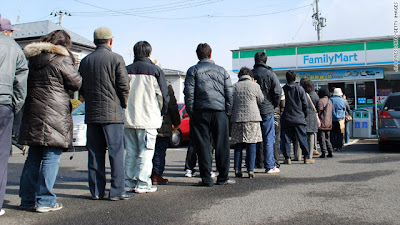 While foreign students put lots of interesting ideas on their blogs, Japanese students, the so-called "native" anthropologists tend to jump on something widely known about Japanese culture. As you see the first post of my blog, I used to draw a fixed image, what is the Japanese culture, merely from my own experiences. It might be helpful for foreign tourists to understand our culture on a superficial level like that from a text or guidebook, although ultimately that kind of touristy marketing drivel counts for nothing in the work of an anthropologist.
While foreign students put lots of interesting ideas on their blogs, Japanese students, the so-called "native" anthropologists tend to jump on something widely known about Japanese culture. As you see the first post of my blog, I used to draw a fixed image, what is the Japanese culture, merely from my own experiences. It might be helpful for foreign tourists to understand our culture on a superficial level like that from a text or guidebook, although ultimately that kind of touristy marketing drivel counts for nothing in the work of an anthropologist.Obviously we have difficulty recognizing visual information here as completely new to us, because we have been exposed to it for all of our lives. However, as I have been gradually spending more time in the field, such as at the morning markets, the Tattoo Party and the careful observation of and interviews with many Osakans, I came to the realisation that I had barely scratched the surface of my own belonging. By diving into areas that I wouldn't normally go, there are full of surprising discoveries. The more I interview other people, the more I can find interesting stories and ideas. So now I am trying to go out of my way and talk with strangers. I know that there are so many stories and ideas behind visual anthropology in Japan, most of which I don’t know. This is what drastically changed of my view of my own culture.
Since I submitted “Order and Disorder in Japan” (my previous post), I have been doing additional research. Recently, I interviewed a professor in a Japanese politics class. Although I have never ever taken a single class by him before, I heard about him from a friend of mine I interviewed, that she learned something related to my research in class, I decided to see him to ask about it.
 Dr. Kazutsura Mori, the head dean of my department, gently gave me an idea of the rules here in terms of Japanese tradition.
Dr. Kazutsura Mori, the head dean of my department, gently gave me an idea of the rules here in terms of Japanese tradition.Postwar Japan has been westernised a lot more that people had given credit for. The government has imported a lot of western values, cultures, thoughts and things like that. In a sense, today we can regard modern Japanese society as a part of western society such as the States and Europe. That is, Japanese society is no longer necessary always different from what American scholars mention about their own their country. David Riesman, a famous sociologist in America, analyzes three types of culture in his book: 'tradition-directed', 'inner-directed' and 'outer-directed'. Some might worry about what others think, while some do not care about what others do. Although according to Riesman, cultural evolution proceeds from “..tradition-directed to outer-directed..”, when it comes to Japan, you can still see a lot of 'tradition-directed' lifestyles in rural sectors. For example, it is the post-Tohoku disaster reaction where little to no looting occurred that people in rural districts generally still have a sense of 'tradition-directed' culture, because of the conservativeness of the advanced generation. On the other hand, in Tokyo, people rushed in throngs to scrounge what they could at supermarkets and from each other. The closer to the large cities, the more people were selfishly focused on self-preservation in time of emergency. After the earthquake disaster here around the Kansai area on January 17, 1994, there was much looting, rape and other heinous crimes in urban areas such as Kobe and Osaka, rather than in the rural districts.
I took notice of warning labels and signage first time doing fieldwork. Now, I am going to make other more venturous research expeditions trying to draw a comparison between the big city and the countryside and more generally, the Japanese history of westernization. So I am planning to go out to a rural community near my hometown, to take pictures and interview the locals. Honestly without the push from this Visual anthropology class I would have never thought of visiting what I'd imagine would be wonderful people.
It is very important and Japanese students should absolutely take advantage of their native title including language and relationships with other Japanese people. Every single piece of Japanese culture is so intertwined that numerous ideas endlessly branch from one topic to another. I feel as if I am following a delicious bread (rice?) trail leading me to places both familiar and unfamiliar at the same time.
Links
CNN: Orderly disaster reaction in line with deep cultural roots
http://news.blogs.cnn.com/2011/03/12/orderly-disaster-reaction-in-line-with-deep-cultural-roots/
























